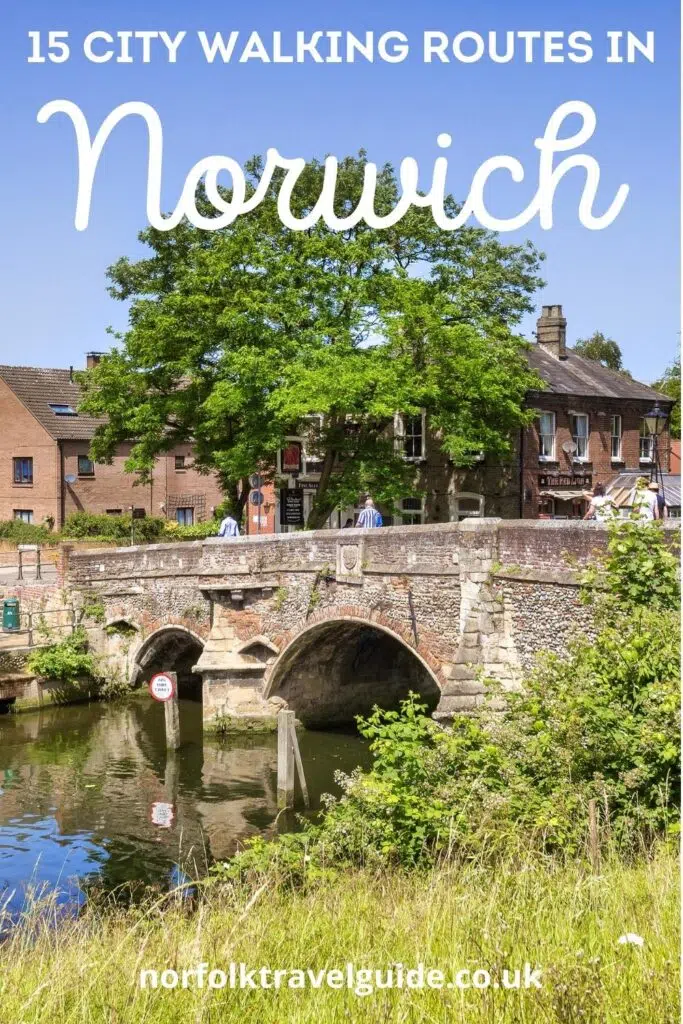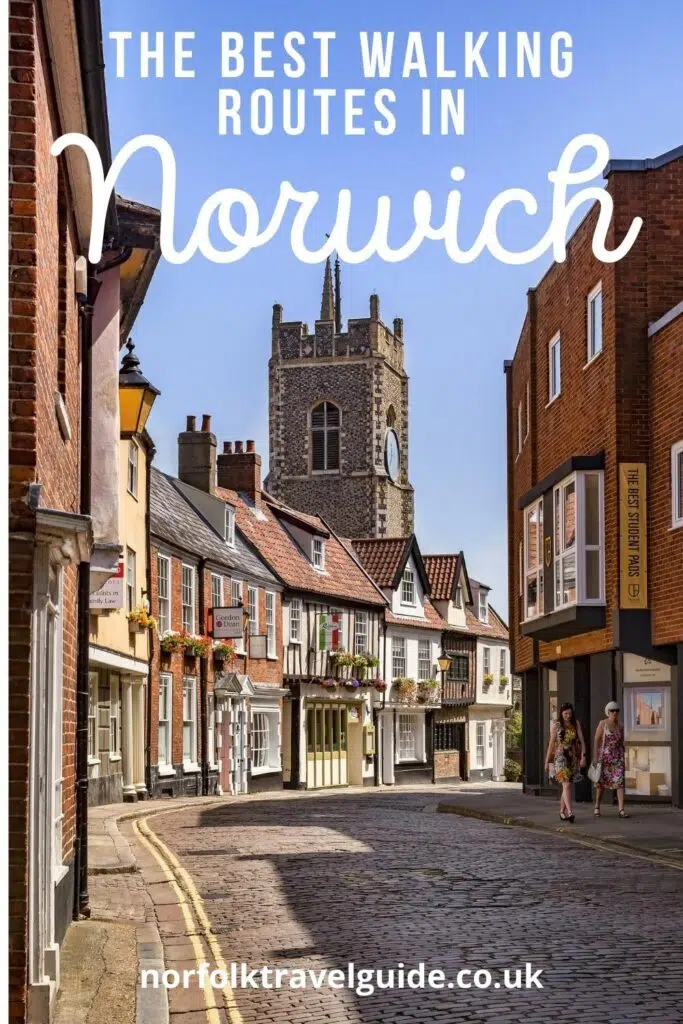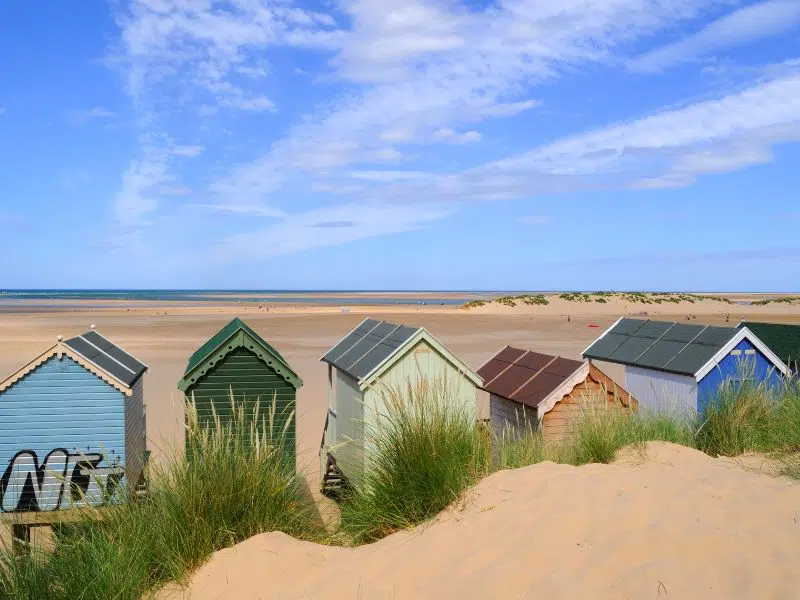Norwich is a wonderful city to explore, and how better to do it than on foot? If you’re interested in history, architecture, the arts and nature, there’s a Norwich city walking route that’s perfect for you!
From riverside walks, to strolls around historic streets, guided walks and nature trails, Norwich is bursting with great places to walk, where you can discover the joys and hidden gems of this compact and cultural city.
I’ve put together a guide of my favourite Norwich walks, with detailed directions and, where required, links to interactive maps. All you need to do is put on your walking shoes and go exploring!
RELATED POST: The Ultimate Local’s Guide to Norfolk England
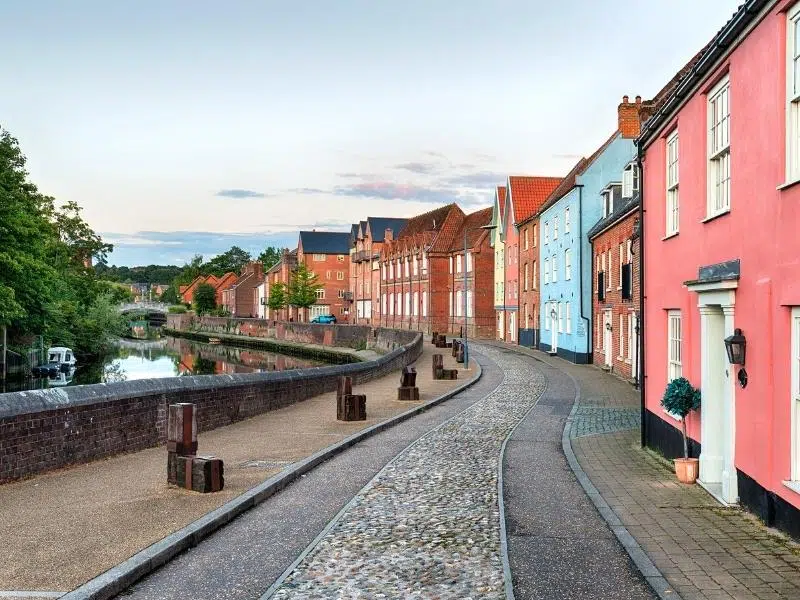
This post may contain affiliate links. If you book something I recommend, I make a small commission without affecting the price you pay!
- Norwich Riverside Walk
- University of East Anglia Lake Walk
- Cathedral Close Walk
- Norwich City Walls Walk
- Whitlingham Country Park
- Norwich Bridges & Churches Trail
- Norwich Garden Walks
- Paul Dickson Guided Walking Tours Norwich
- Norwich Urban Art Trail
- The Norwich 12 Route
- Yare Valley Walk
- Norwich Mystery Treasure Trail
- Mousehold Heath Earth Heritage Trail
- Norwich Nooks & Crannies Walk
- Norwich Ghost Walks
Norwich Riverside Walk
Length: 1.1 miles
Time: 30 minutes walking, but you’ll need much longer to explore, and maybe stop for a pint if local ale!
Suitability: Dog and family friendly, suitable for pushchairs and wheelchairs throughout the year.
One of the best short walks in Norwich, this riverside route follows the lush and tranquil river Wensum, past historic buildings and several great pubs, and starts from just outside Norwich train station.
- Cross the bridge outside the train station and on the right, walk through the patio at the Compleat Angler pub and down the stairs.
- Here you’ll find start of the well managed path, lined with statuesque weeping willows.
- Follow the river heading north to picturesque Pulls Ferry, a flint built 15th century watergate, which managed goods coming into the city by water.
- Continue on to the Bishop’s Bridge, build in 1340. A fortified gatehouse stood on the bridge until the 18th century, and the semi-circular projection you can see today was part of the outer turrets. The Red Lion pub on the banks of the river is a good place to stop for a drink and watch the resident kingfishers.
- Walk on to Cow Tower, one of the earliest artillery blockhouses in England which dates from 1398, and gets its name from the water meadow on which it stands, Cowholme.
- Continue on the path until you reach Riverside Park, where you can cut through the pay and display car park, past the Adam and Eve pub (the oldest pub in Norwich) to Norwich Cathedral.
- Or, continue on past the courts, and onto colourful Quayside, before arriving at Fye Bridge. Look back for one of the most photographed sights in Norwich!
From here, you can head south on Wensum Street which leads to Tombland, home to medieval St. Ethelbert’s Gate dating from 1272 and Erpingham Gate, dating from 1420. The Cathedral Quarter and Elm Hill are also within a few minutes walk of the bridge, making an easy link with the Cathedral Close Walk.
This linear route can easily be made circular by continuing over Fye Bridge to Tombland, and then picking up the Prince of Wales Road back to the river and train station, which will add 0.7 miles and 15 minutes of walking on to your walking itinerary.
Norwich Train Station is also the start point of the historic Wherryman’s Way, which follows the River Yare for 37 miles through the Norfolk Broads, all the way the Norfolk Coast.
RELATED POST: 13 of the Best Norfolk Broads Walks
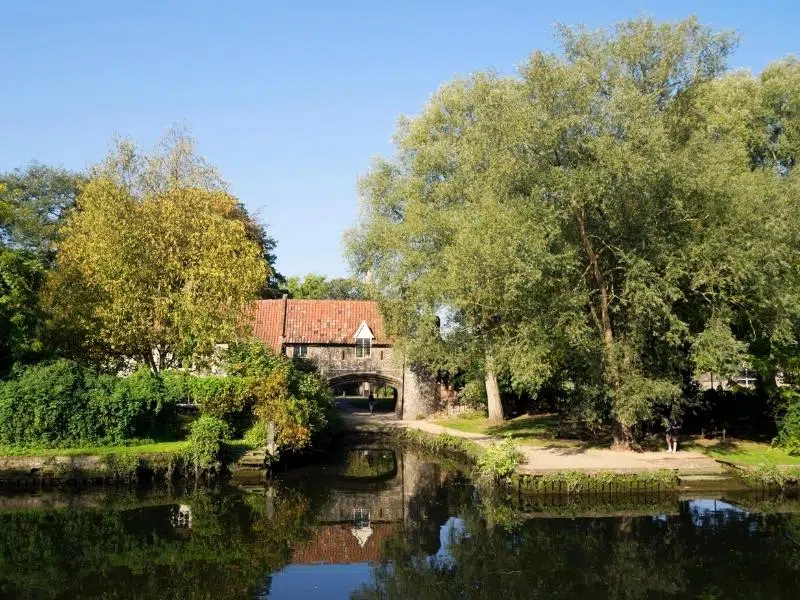
University of East Anglia Lake Walk
Distance: 2.8 miles
Time: 1 hour of walking, longer if you want to stop and explore the sculptures.
Suitability: Family and dog friendly, suitable for pushchairs and off-road wheelchairs in the dry.
This is a lovely circular walk around the UEA Broad, and much of the route follows the UEA Wildlife Trail. There are lots of off-shoots and opportunities to explore in and around the UEA campus.
- Start at Eaton Park Car Park, where there is plenty of free parking, and head west through the park, parallel with North Park Avenue.
- Turn right on Bluebell Road and then cross over at the zebra crossing to take the track in front of you, which heads to the lake.
- Once you reach the UEA lake path, take a right turn. This path can get really muddy after heavy rain, so wellies might be a good option! There are lots of benches, BBQ points and great places to stop for a picnic along the path. There are also places to access to lake, so keep an eye on little ones.
- As you start to turn south, take the path north to the Sainsbury Centre for Visual Arts, and have a wander around the outdoor sculpture park, which is free for all to enjoy.
- Pick up Norfolk Road, in front of the Sainsbury Centre to the roundabout, and take the first exit, where you’ll see the track which leads back to the lake.
- Once you reach the lake path, turn right and follow the track along the south of the lake. A few hundred metres along is the River Yare and a small metal bridge. You do not need to cross the bridge, but it’s a great spot for a game of Pooh sticks!
- Continue on the path between the river and Broad, and spot the ‘Stone Man’ sculpture, an 8ft bronze statue by acclaimed sculptor Laurence Edwards, depicting a man who appears to be emerging from a lagoon.
- Continue to follow the path until you arrive back at the point at which you joined, and from there back through Eaton Park to the car.
- In spring, you can wander through Bluebell Wood on the way back to the car park, enjoying the beautiful carpet of spring flowers that are abundant here in April and May each year.
RELATED POST: 21 Museums in Norfolk You Won’t Want to Miss!
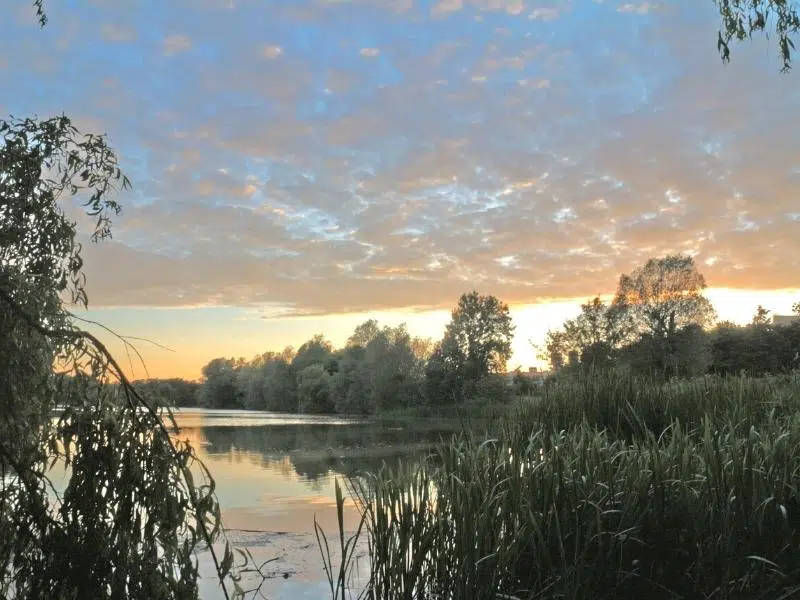
Cathedral Close Walk
Distance: 1.5 miles
Time: 40 minutes of walking, longer if you want to stop and explore the Cathedral and various buildings open to the public.
Suitability: Family and dog friendly, suitable for pushchairs and wheelchairs in all weathers.
Arguably the most historic area in Norwich, Cathedral Close is home to buildings dating from the foundation of Norwich Cathedral in the late 11th century, 80 of which are listed.
The layout has changed little since the Reformation and today it remains an oasis from the bustle of the city outside its two main gates, which are its only access through the Precinct Wall, which effectively cuts the 44 acre Close off from the rest of the city.
It’s a tranquil and atmospheric place for a meander, as you admire the architecture and buildings, and try to imagine what life in the Middle Ages might have been like.
Start at the Upper Close, a large open green square dominated by the Cathedral and Cloister and separated from Tombland by the historic gates of St. Ethelbert’s Gate and Erpingham Gate. You can enjoy a free guided tour of Norwich Cathedral, which take place on the hour between 10am and 3pm daily.
Pass the Cloister and make your way around the east end of the Cathedral and Life’s Green, where you can find the grave of Edith Cavell, the Norfolk nurse and heroine executed in 1915 for assisting Allied soldiers to escape from German occupied Belgium. Her memorial stands on Tomband, just outside the Erpingham Gate.
To the north of the Cathedral is the Norman Bishop’s Palace, where you can pop into the Bishop’s House Gardens, and former Carnary College which are now parts of the private Norwich School, which dates back to the founding of the cathedral by Bishop de Losinga in 1096. From the Bishop’s Palace it’s a three minute walk to the Adam and Eve Pub, the oldest pub in Norwich.
To the south head towards Almary Green, a private garden surrounded by impressive Georgian buildings. Although you can’t access the garden, it is visible and it’s worth stopping to enjoy the view.
From there, walk on the The Lower Close, which forms a separate green area to the east and flows into Ferry Lane, which was formerly a canal running down to Pulls Ferry and the Norwich Riverside Walk. Hooks Walk runs from the north east corner of The Lower Close and is a narrow, bending lane with mostly functional buildings lining the footpath.
By contrast, Bishopgate is wider and well lined by buildings for most of its length. These include on the north side the Great Hospital and St Helen’s Church. The leg which runs north-south does not have buildings at the back of the footpath, though the sense of enclosure is maintained by high and attractive walls.
RELATED POST: Norfolk Churches: 16 of the Best to Visit
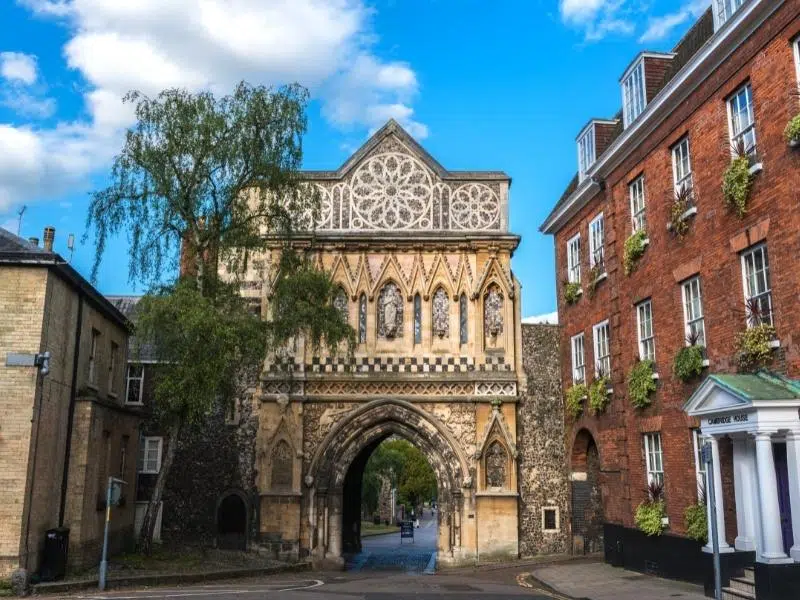
Norwich City Walls Walk
Distance: 1-2 miles
Time: 1 hour of walking, longer if you want to stop and see other Norwich attractions along the way.
Suitability: Family and dog friendly, mostly suitable for pushchairs or wheelchairs year round.
Work started on the walls of Norwich city in 1294, and they were completed in the mid-14th century. The walls formed the longest circuit of urban defences in Britain, eclipsing even those of London, and fitting for the important and wealthy medieval city.
Norwich’s walls were made of flint, the local and plentiful building material, with brick and stone reinforcements. The walls loomed seven meters high and had a deep outer ditch making the fortifications even more impressive from the outside.
Twelve gates and 40 towers controlled the main thoroughfares into Norwich, as well as the pair of Boom Towers on the river controlling access by water. The gates were demolished in the late 18th to early 19th centuries to make way for increasing road traffic.
Today only fragments of the walls remain but, you can discover that much of Norwich’s medieval past is still visible when you follow this collection of City Walls Walks from the Norwich Society.
Each walk takes you to a different area of the city to see the remains of the medieval walls. You will explore the Cathedral precincts, Norwich Over the Water, the Riverside, the industrial heritage of the city, and the famous 18th century Pleasure Gardens.
RELATED POST: 31 Amazing Things To Do in Norwich
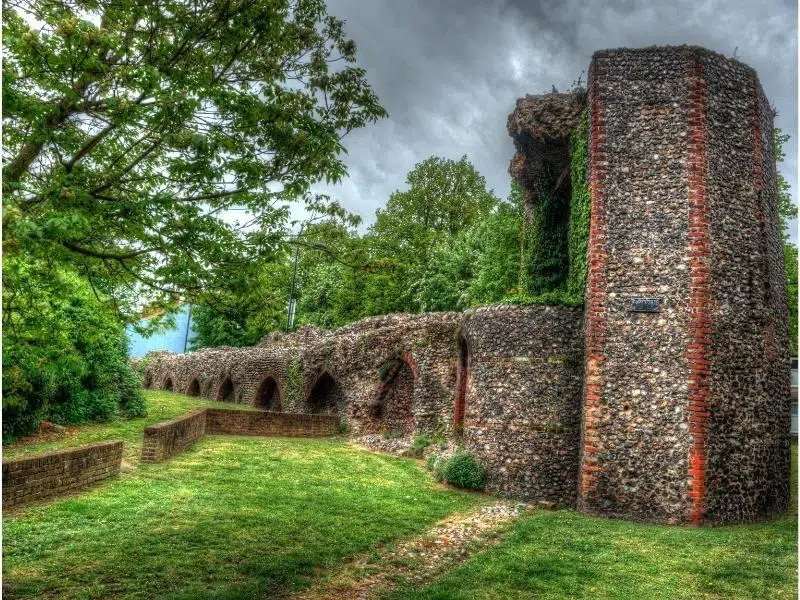
Whitlingham Country Park
Distance: 2 miles
Time: 1 hour of walking, longer if taking a picnic or wanting to spot wildlife.
Suitability: Family and dog friendly, suitable for pushchairs and wheelchair accessible in all weathers.
Just southeast of Norwich situated near the pretty village of Trowse lies the wonderful Whitlingham Country Park. One of the largest parks in Norwich, you can cycle here on a Beryl Bike picked up in central Norwich in around ten minutes.
This walk is a circular route right around Whitlingham Great Broad. There are toilets and a cafe near the car park, and a picnic meadow adjacent. You can also hire kayaks here, if you fancy a paddle after your walk.
- Start at the Whitlingham Country Park Visitor Centre car park.
- From the Visitor Centre car park, head towards the Broad and turn right onto the surfaced Whitlingham Lane.
- After about 50 metres, turn left onto gravel path, waymarked Wherryman’s Way, towards the Broad.
- Turn right and follow the path by the Broad which runs parallel with Whitlingham Lane.
- Leaving behind Whitlingham Lane, the path runs around the end of the Broad passing close to the River Yare.
- The path enters a small woodland of poplars and willows, before passing through an open area of grassland.
- The nature reserve, which follows the northern shore, is home to classic Broads wildlife, like Egyptian geese, mute swans, wildfowl, dragonflies and an occasional sighting of the iconic swallowtail butterfly. It is particularly important to keep dogs on leads in this area.
- At the Whitlingham Outdoor Education Centre, take the surfaced path to the left and where the path runs between the Great and Little Broad, and go left at the little coppice wood onto Whitlingham Lane.
- Turn left, noting the ruin of Trowse Newton Hall and the Lime Avenue and arrive back at the car park.
RELATED POST: 26 Exciting Things To Do On the Norfolk Broads
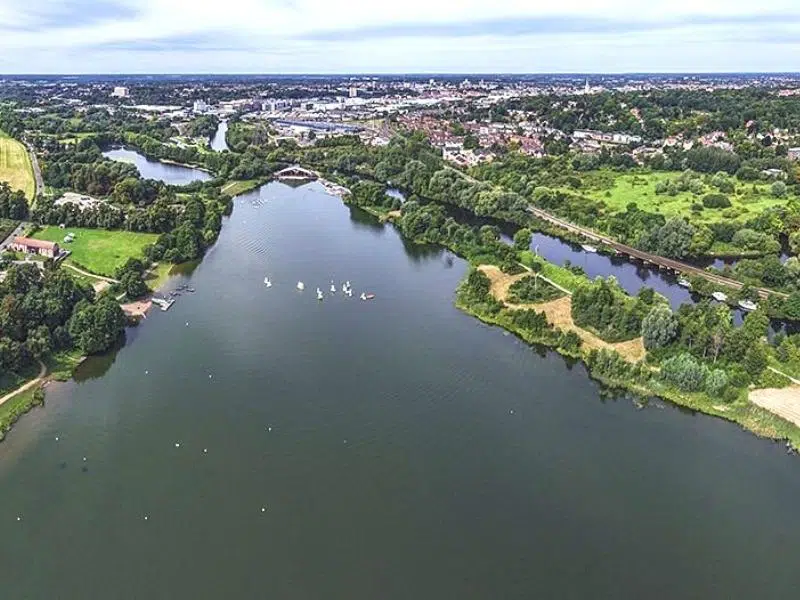
Norwich Bridges & Churches Trail
Distance: 4.7 miles
Time: 2.5 hours of walking, longer for photography stops!
Suitability: Family and dog friendly, suitable for pushchairs in all weathers. There are a couple of flights of stairs to negotiate, which are possible with a puchchair, but may not be accessible with a wheelchair.
This is a delightful circular walk around Norwich. The second half of the walk partly follows the Norwich Riverside Walk, criss-crossing the river over the city’s bridges, before returning through the histroci centre, where you’ll catch sight of the ancient city walls, the Norman castle, numerous churches, and lots of Norwich hidden gems.
This interactive map has waypoints and directions to use along the route.
How to use this map – Use your finges (or computer mouse) to zoom in and out. Click or touch the icons to get more info about a place, and click the arrow in the box top left to open the index. To add to your own Google Maps account, click the star next to the title of the map.
- Start at Westwick Street pay and display car park which is on the junction of Westwick Street and Barn Road in Norwich.
- Leave the car park and turn left into Westwick Street, then left again into New Mills Yard, where you’ll see a plaque set into the wall marking the various flooding over the decades.
- Cross New Mills Bridge and on the left you’ll see the restored New Mills Compressor Station, built in 1898 to produce compressed air to operate air ejectors to pump sewage in Norwich.
- Turn right to follow the path, with the River Wensum on the right, and cross Coslany Bridge, a green metal bridge built in 1804.
- Turn right over the bridge and continue ahead until you reach the T-junction with the main road, with St Lawrence Church ahead of you.
- Turn left onto the pavement heading uphill and opposite the Gyre and Gimble Bar and Distillery, merge left onto Charing Cross.
- Pass Strangers Hall on your right, a Grade One Tudor merchant’s house which has been used as a museum of local history since the 1930s.
- At the traffic lights turn left into Duke Street. Cross over the river and on the left you’ll pass Norwich University of the Arts, housed in a beautifully preserved Victorian building.
- Soon afterwards cross the road via pedestrian crossing with lights and continue right along Colegate. Pass by St George’s Church on the left and reach the cross roads with St George’s Street. This whole area was once home to a thriving textile industry which gave the city its medieval wealth.
- Turn right into St George’s Street. Before you reach the bridge you will see Norwich Playhouse on the right, and on the left is St George’s Green, home to the ‘Sea Form (Atlantic)’ sculpture dedicated to the famous artist Dame Barbara Hepworth.
- Ahead is St George’s Bridge, built of Portland stone in 1784, with a single span of 12.8 metres.
- Cross the bridge and take the first left through the bollards to pass under an archway into an old courtyard surrounded by College of the Arts buildings and the remains of a former monastery.
- Follow the path turning left and then right until you reach Monastery Court car park, and continue to Elm Hill.
- Turn left at Elm Hill, a picture-perfect medieval cobbled street which is lined with colourful and historic Tudor houses, many of them now pretty shops, restaurants, and cafes.
- Continue along Elm Hill until you reach Wensum Street, and turn left to cross Fye Bridge.
- Take a right turn onto Fishergate. Pass by Old Miller’s Wharf and the Church of St Edmund, on the right. This church is dedicated to the royal martyr King Edmund of the East Angles who was killed by the Vikings in the year 869.
- At the end of the road, turn right over Whitefriars Bridge. Cross the road and go down the short flight of steps to reach the riverside path. On the opposite bank you will see the tall brick built structure of St James’ Mill, an 1836 Grade I listed building on a site originally occupied by the White Friars or Carmelite Friars from 1256, and one of the Norwich 12.
- Continue ahead with the river on your left. Follow the gravel path as it winds through the small grass area. From here you can head to the Adam and Eve pub for a well-deserved drink, before picking up the Norwich Riverside Walk at point 5, going in reverse.
- At the Compleat Angler, we leave the Norwich Riverside Walk and cross Foundry Bridge.
- Pass by Norwich Sea Cadet’s training ship, TS Lord Nelson, and alongside a number of cafes and restaurants.
- Take a left turn up a few stairs towards the cinema and turn right to cross over the modern suspension bridge, Lady Julian Bridge.
- Continue on to Old Barge Yard, and at the T-junction turn right onto King Street, and take the next right again. On the corner here is Dragon Hall, a superb Grade I listed and restored medieval trading hall dating from 1430, and another of the Norwich 12. Today, Dragon Hall is the National Centre for Writing, befitting for England’s first UNESCO City of Literature and honouring the greatest mystic of the Middle Ages, Julian of Norwich, who was the first woman to write a book in English.
- Head back down King Street the way you came to another suspension bridge, the Novi Sad Friendship Bridge, built in 2001.
- After crossing the bridge, turn sharp left and left again to return to the river bank. Follow the path with the river on your right.
- Keep left at the fork, heading uphill past the leisure centre on the left.
- At the top of the footpath turn right to cross the final bridge on the walk, Carrow Bridge, built as a lifting bridge to allow trade ships to pass up the river.
- Turn right into King Street.
- Continue for a little distance and then turn left up a few steps onto the footpath along Southgate Lane, and pass the ruins of St Peter of Southgate.
- Continue up the steep and walled footpath to the top where you will see the entrance gates for Southgate House. Turn left and follow the wider vehicle road continuing uphill.
- At the T-junction turn right onto Bracondale.
- After just a short distance keep right into Ber Street., where on the right you’ll see an old section of the city wall, which was completed by the middle of the 14th century.
- Continue ahead along Ber Street. On the left you’ll pass a large deconsecrated church and the remains of St Bartholemew’s Church, a 14th century church which was desecrated in 1549. Continue ahead to pass by the John Lewis department store on the left.
- At the junction, cross and head down the pedestrian walkway of Timber Hill, to the left of St John the Baptist Church. Timber Hill was originally known as Durnedale by the Anglo-Saxons and later in the Middle Ages known as Swine Market Hill, then Timber Market Hill.
- Pass by Castle Mall shopping centre on the right hand side. At the bottom of the hill you will reach a pedestrian crossing. Over to the right you will be able to see Norman built Norwich Castle, which today is a museum and art gallery, and another of the Norwich 12. Cross over the pedestrian crossing and then fork right down White Lion Street.
- Keep right to pass the Castle Mall entrance and go ahead along the shopping precinct.
- Cross London Road and go down the narrow Swan Lane.
- At the T-junction turn left into Bedford Street.
- At the crossroads, go straight ahead into Lobster Lane.
- Continue ahead on Pottergate passing St John Maddermarket Church on the right hand side. You will pass St Gregory’s Church on the right.
- Turn right in front of St Gregory’s Church and go down the small footpath to the left of the church, St Gregory’s Alley.
- Turn left into St Benedict’s Street. Pass by St Margaret’s Church of Art on the right and then a converted church which is now Norwich Arts Centre.
- Continue along St Benedict’s Street until you reach St Margaret’s Street, and turn right.
- At the T-junction with Westwick Street, turn left and fork right. The car park is just over the road.
RELATED POST: 12 Norfolk Castles for You to Explore

Norwich Garden Walks
Distance: Various
Time: As long as you want!
Suitability: Family friendly and some areas suitable for pushchairs and wheelchairs. Only assiatance dogs allowed.
There are a couple of city gardens in Norwich that are perfect for a gentle meander in between shopping, or other sightseeing. There are no specific routes for these gardens, but both are big enough to spend an hour or so strolling and exploring, and also make the perfect lunch stop with a picnic.
The Plantation Garden
Known locally as the ‘Secret Garden’ and one of Norwich’s best hidden gems, this three acre Grade II English Heritage registered garden was established over 100 years ago in an abandoned chalk quarry, just a few hundred yards from the city centre. The garden fell into disrepair after the Second World War but was restored in 1980 to the paradise it is today.
The Plantation Garden features lush green planting, gothic features, an Italianate terrace, woodland walkways and a gorgeous greenhouse and is the perfect place to get away from the buzz of Norwich city centre for a few hours to enjoy a spot of peace and tranquility.
Just up the road from the Cathedral of St John the Baptist, you could also include this garden as a stop on the Norwich 12 Walk, which covers twelve of the most historic iconic buildings in Norwich.
The Bishop’s House Gardens
The Bishop’s House Gardens are actually the Bishop of Norwich’s historic private gardens and a four acre oasis of colour and calm amidst the hustle and bustle of the busy city. Full of horticultural delights, you’ll enjoy a few hours of respite here.
The garden is full of enticing areas including a fragrant herb garden, beautiful long herbaceous borders, a jungle walk, a bamboo walk, a wonderful wildflower labyrinth and extensive shrubberies containing many rare and unusual plants, and even a hebe planted (and thriving!) from a sprig taken from Queen Victoria’s wedding bouquet in 1840.
There is an organic working kitchen garden, fruit orchard and bee hives, and a popular plant sales area, where you can buy the plants, mostly grown from seed or propogated, that you see in the garden today. Why not incorporate this garden into the Cathedral Close Walk?
RELATED POST: The 21 Best Gardens in Norfolk to Visit
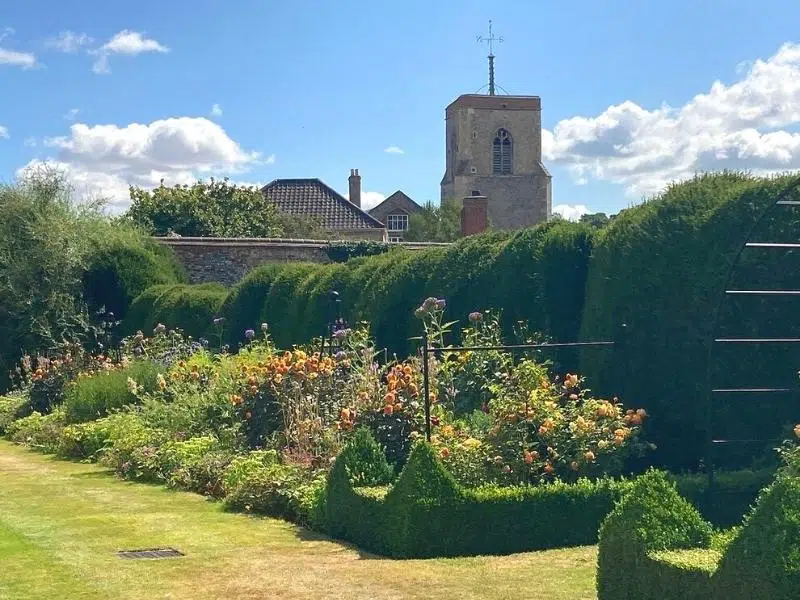
Paul Dickson Guided Walking Tours Norwich
Distance: Various
Time: 1.5 hours to a half day walking time.
Suitability: Family and dog friendly (on a lead) and suitable for pushchairs and wheelchairs, but do check at the time of booking.
If you prefer to have an orgainsed small group walking tour with a knowledgeable guide, then Norfolk local Paul Jackson is the most experienced, highly rated and fully qualified official City of Norwich tourist guide.
You can choose from a great selection of Norwich guided tours, and see whichever bits of the city interest you the most!
- Shardlake’s Norwich – celebrating CJ Sansom’s best-selling novel Tombland, featuring Tudor lawyer Matthew Shardlake.
- Norwich, An Introduction – discover more than 1000 years of Norwich history.
- Norwich: A Black History – celebrates the diverse contribution of black people to the history of Norwich and Norfolk.
- The Pastons in Norwich – following in the footsteps of the letter-writing 15th century Pastons.
- Historic Pubs of Norwich – Get a taste for the history of Norwich pubs and Maids Head Ale, brewed by Woodfordes.
- Boardman and Skipper – celebrates the architectural legacy of the great Norwich architects Edward Boardman and George Skipper.
- Norwich – The City of Stories – showcases the writers who have lived in the city and those who have written about Norwich.
- Maids Head Hotel, Tombland & Elm Hill – visit historic Tombland, Norwich’s ancient Anglo-Scandinavian Market Place and picturesque Elm Hill, with coffee or tea and stories at the historic Maids Head Hotel.
- Rivers, Merchants and Markets – explore the River Wensum, the oldest hotel in the UK, the Museum of Norwich and sample food on Norwich Market.
- Norwich on the Dark Side – discover the darker side of Norwich, crime, punishment, filth and misery!
- The Great Market – explore in and around Norwich Market, celebrating 940 years of buying and selling at the heart of the city.
- Historic Colegate – explore Colegate and Elm Hill, an area bursting with the history of Norwich.
- Norwich – Historic Alleys, Lanes and Passages – discover the stories of Norwich’s historic alleys, lanes and passages.
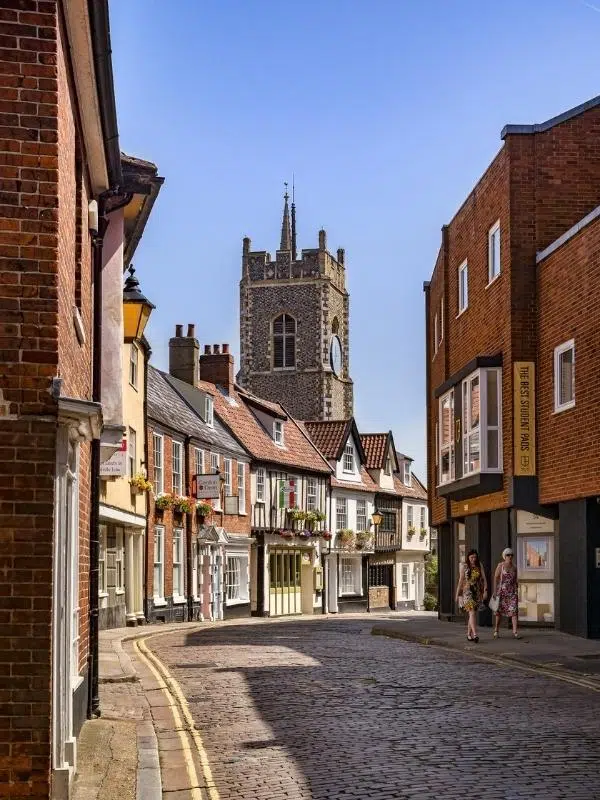
Norwich Urban Art Trail
Distance: 2.5 miles
Time: 1 hour walking time, but longer if you want to see other Norwich highlights along the way.
Suitability: Family and dog friendly and suitable for pushchairs and wheelchairs year round.
Art has long been a story in Norwich, and you don’t have to travel far around the city to see it. Expressed through many mediums, art in Norwich tells its stories in wonderful city venues hosting a variety of artistic styles and artists.
Outside art, or street art, has become just another way of telling a story on a large scale. Urban art speaks to the gritty reality of city life and Norwich has nine large murals across the city, with a further twelve smaller pieces within Norwich Market.
You can discover all of this street art as you walk around the city and follow our Norwich walking tour interactive map complete with directions.
RELATED POST: 26 Pictures of Norfolk England to Inspire Your Trip!
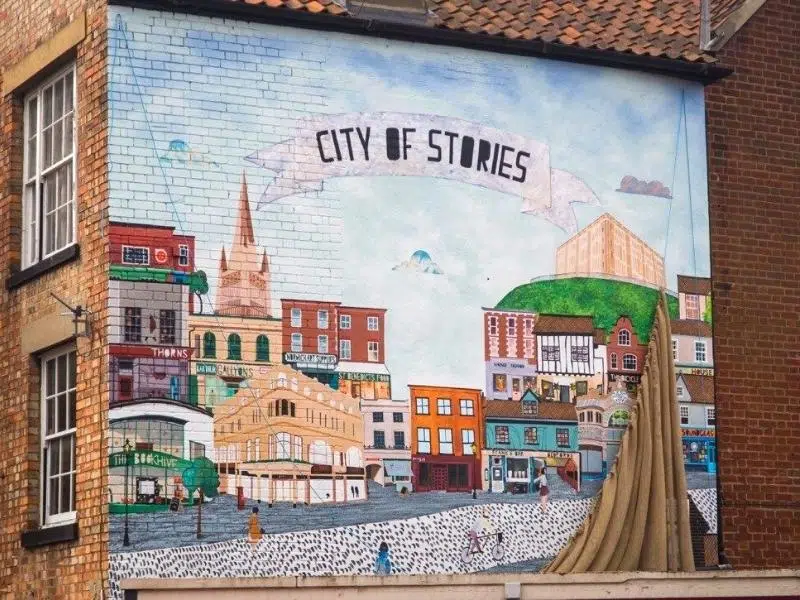
The Norwich 12 Route
Distance: 3.7 miles
Time: 1.5 hours walking time, but longer if you want to see other Norwich highlights along the way.
Suitability: Family and dog friendly and suitable for pushchairs and wheelchairs year round.
The Norwich 12 was an initiative by the Norwich Heritage Economic and Regeneration Trust (HEART) to develop twelve of Norwich’s most iconic buildings into heritage attractions, to act as a showcase of English urban and cultural development over the last 1,000 years.
The 12 buildings are a collection of architectual styles that span across Norman, medieval, Georgian, Victorian and modern eras – with one building for each century. Visting them all makes for one of the best walks around Norwich for history and architecture buffs.
Taking a self-guided walking tour to see each of the twelve is an easy way to discover the history of Norwich and understand the industry, tradition, culture and people who have shaped the city.
While not all of the Norwich 12 attractions are open to the public, they can all be explored by means of tours, exhibitions and performances at the venues, or via heritage interpretation leaflets and totems, signage, websites and guide books. This interactive map has waypoints and directions to use along the route.
How to use this map – Use your finges (or computer mouse) to zoom in and out. Click or touch the icons to get more info about a place, and click the arrow in the box top left to open the index. To add to your own Google Maps account, click the star next to the title of the map.
Norwich Castle (1067–1075)
Norwich Castle is built on a large artificial mound in the centre of Norfolk’s capital city, and consists of a magnificent Norman keep constructed in 1095 by William II, as part of his campiagn to subjugate East Anglia after the Normon Conquest of England.
The Castle site comprises the 900 year old Castle, and a large museum art gallery complex converted from the city’s Victorian prison, which houses internationally important collections in archaeology, natural history, regimental history, and fine, decorative and contemporary art.
Norwich Cathedral (1096–1145)
Built between 1096 and 1145, and unique for its soft creamy limestone exterior, the Norman architecture of Norwich Cathedral is still intact and forms one of the most complete examples of the Romanesque style in Europe. Some of the original Norman wall painting survives in the Cathedral’s Jesus Chapel and the presbytery.
Norwich Cathedral has the highest Norman tower at 40 metres, the second highest spire in England after Salisbury Cathedral at 96 metres, and the largest monastic cloisters in England, as well as a unique collection of medieval roof carvings.
The Great Hospital (1249)
In continuous use for more than 750 years, Norwich’s Great Hospital was founded in the Middle Ages for the care of poor chaplains in the 13th century.
The site includes the ancient parish church of St Helen, Birkbeck Hall with its Gothic Revival architecture, and Eagle Ward with its lavishly decorated ‘eagle ceiling’, originally the chancel of the church. Today the hospital provides sheltered housing and a residential care home.
The Halls – St Andrew’s and Blackfriars’ (1307–1470)
St Andrew’s Hall is the centrepiece of several flint buildings, which together are known as The Halls, and form the most complete friary complex surviving in England today.
During the Reformation, the site was saved by the City Corporation, which bought it from the king for use as a ‘common hall.’ Today the two halls, crypt, chapel and cloisters host conferences, fairs, weddings and concerts.
The Guildhall (1407–1424)
The elaborate design and size of Norwich Guildhall reflect the city’s status as one of the wealthiest provincial cities in England in the Middle Ages. Norwich was given more self-governing powers in 1404 and the Guildhall was built to house the various civic assemblies, councils and courts that regulated the lives of Norwich’s citizens.
Dragon Hall (1427–1430)
Lost for centuries, the superb Grade I listed Dragon Hall is a restored medieval trading hall dating from 1430. The breathtaking Great Hall features an impressive timber crown-post roof and intricately carved and painted dragon. It was once at the heart of an international trading empire, and would have been used to store and sell wool, cloth, timber, spices and other items of value.
Now, the National Centre for Writing is found at here, befitting for England’s first UNESCO City of Literature and honouring the greatest mystic of the Middle Ages, Julian of Norwich, who was the first woman to write a book in English.
The Assembly House (1754–1755)
The Assembly House is a Georgian building designed by the architect Thomas Ivory. It incorporates the original layout of a previous building, the medieval college of St Mary in the Fields. When it opened, the Assembly House was used as a centre for entertainment and assemblies for the local gentry.
During its long history it has hosted a waxworks exhibition by Madame Tussaud, a concert by the composer Franz Liszt, and many balls. Today the rooms appear almost exactly as they did at the height of the Regency period, and the building is one of Norwich’s top hotels. One of the best ways to see inside is to book one of the most delicious afternoon teas in Norfolk!
St James Mill (1836–1839)
St James Mill is an English Industrial Revolution mill built on a site occupied by the White Friars or Carmelites in the 13th century, and an original arch and undercroft survive. When the local textile trade went into decline, St James Mill was bought by Jarrold & Sons Ltd (of department store fame) in 1902.
The building was subsequently leased to Caley’s, the chocolate manufacturer, and sold to the government as a training factory for war veterans in 1920. Jarrolds bought back the mill in 1933 and today it is a private office complex. The John Jarrold Printing Museum is situated behind the mill.
The Cathedral of St John the Baptist (1884–1910)
The Cathedral of St John the Baptist is a fine example of 19th century Gothic Revival architecture. By the 19th century Catholics in England were once again free to worship in public, and the Cathedral was a gift to the city by Henry Fitzalan Howard, 15th Duke of Norfolk, as part of his personal mission to bring Catholicism into the centre of English life.
Just along Earlham Road is the fabulous Plantation Garden, a lovely place to stop for a rest on this walk.
Surrey House (1900–1912)
Surrey House, the historic home of insurance company Aviva (formerly Norwich Union), is a stunning piece of Edwardian architecture designed by George Skipper. The building has a commanding Palladian exterior and an interior adorned with fifteen varieties of marble, classically inspired frescos and a glass atrium.
City Hall (1936–1938)
Norwich City Hall was completed in 1938 when the Guildhall and existing municipal offices could no longer accommodate the growth in local government personnel. The city council consulted the Royal Institute of British Architects (RIBA) and organised an architectural competition to design a new municipal building. Norwich City Hall has an art deco interior, a top-floor cupola, mahogany panelling and one of the longest balconies in England.
The Forum (1999–2001)
Sandwiched between Norwich market and Chapelfield Gardens, with St Peter Mancroft, Norwich’s largest 15th century parish church standing guard, the The Forum is a contemporary landmark community building which is always busy.
Home to the Norfolk and Norwich Millennial Library and BBC East, you’ll also find street performers playing to the crowds outside, live music events, food and craft markets inside, or one of the many other events held here. The Forum a great place to stop by, grab a coffee, and see what’s happening.
RELATED POST: Afternoon Tea in Norfolk – 15 of the Best Places
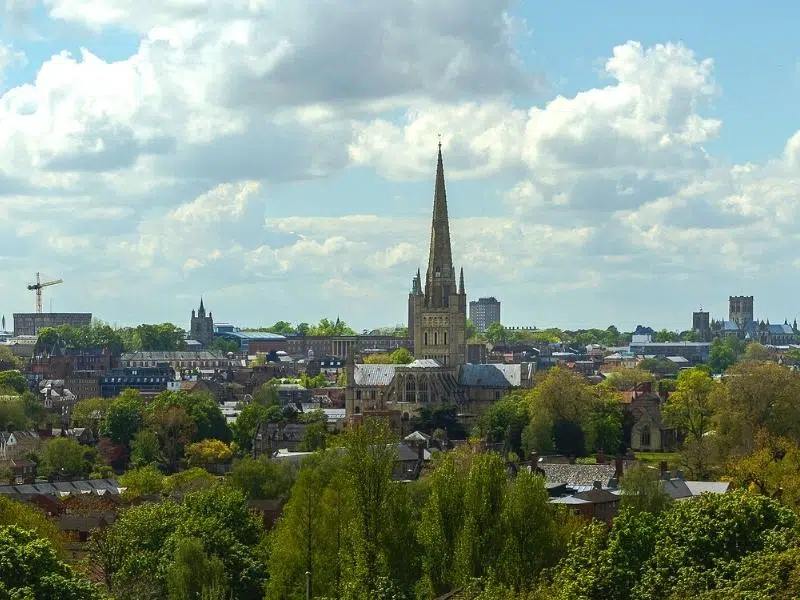
Yare Valley Walk
Distance: 6.2 miles
Time: 2-3 hours walking time, but longer if you want to stop and spot wildlife on the way.
Suitability: Family and dog friendly, some paths may be muddy and inaccessible to puchchairs and wheelchairs after heavy rain.
The River Yare is some 58 miles in length, rising at Garvestone in the Norfolk Brecks, before winding it’s way through the Norfolk Broads to the sea at Great Yarmouth.
In the Norwich area the Yare valley is diverse, from the broad flood plain in the Easton area, to the steep wooded slopes as the river leaves the city for Thorpe and Trowse. The river is considered to be important for the wildlife it supports.
This linear Norwich river walk follows the River Yare from Bowthorpe Southern Park as it twists and turns its way to Marston Marsh and Harford Bridge through a range of different habitats. You’ll pass through four local nature reserves – Danby Wood, Marston Marsh, Earlham Park Woods and Bowthorpe Marsh.
It is possible to return from the end point at Harford Bridge to the Bowthorpe Southern car park by bus. Pick up bus 36 by the Marsh Harrier pub, a two minute walk from Harford Bridge. Alight at Castle Meadow and walk three minutes to the Red Lion pub bus stop and hop on the 26A bus to Dow Close, a four minute walk to the car park. The journey takes around 53 minutes.
Get a downloadable PDF of instructions and a map from the Yare Valley Society here.
RELATED POST: 13 Exciting Things To Do in Great Yarmouth
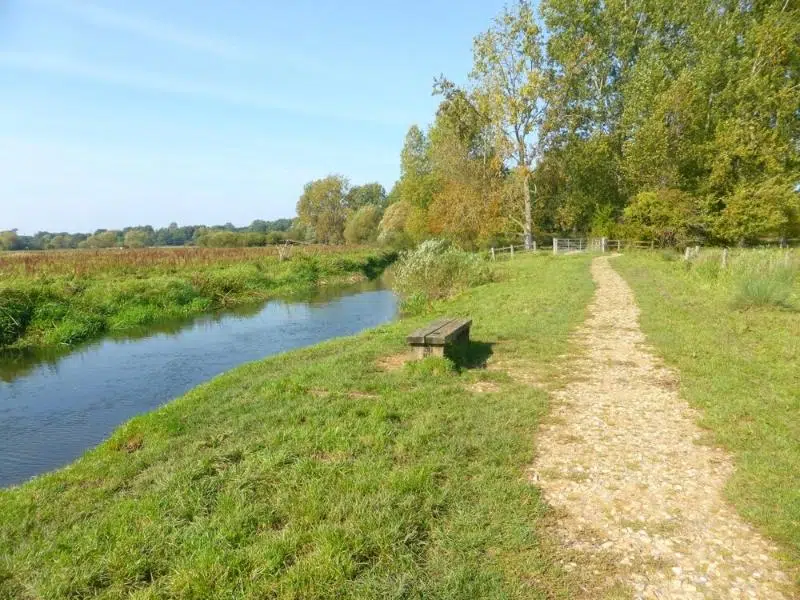
Norwich Mystery Treasure Trail
Distance: 1.5 miles
Time: 40 minutes of walking, but you’ll need longer to solve all the clues!
Suitability: Family and dog friendly, pushchair and wheelchair accessible year round.
If you’re looking for things to do in Norwich for families, the Norwich Mystery Treasure Trail is a detective game that’s a great way to get kids interested in the history of the city.
Just download from Treasure Trails and follow the map to find clues and work out who has stolen a priceless statue from Norwich Cathedral grounds.
As you weave your way along the 1.5 mile trail between Norwich Cathedral, Elm Hill, Tombland and St Andrews Street, you’ll be looking for clues on local landmarks, signs and buildings, whilst trying to solve the ‘crime’.
Teenagers may prefer City Escape Games, a self guided city adventure where you can solve cryptic puzzles around Norwich using your phone.
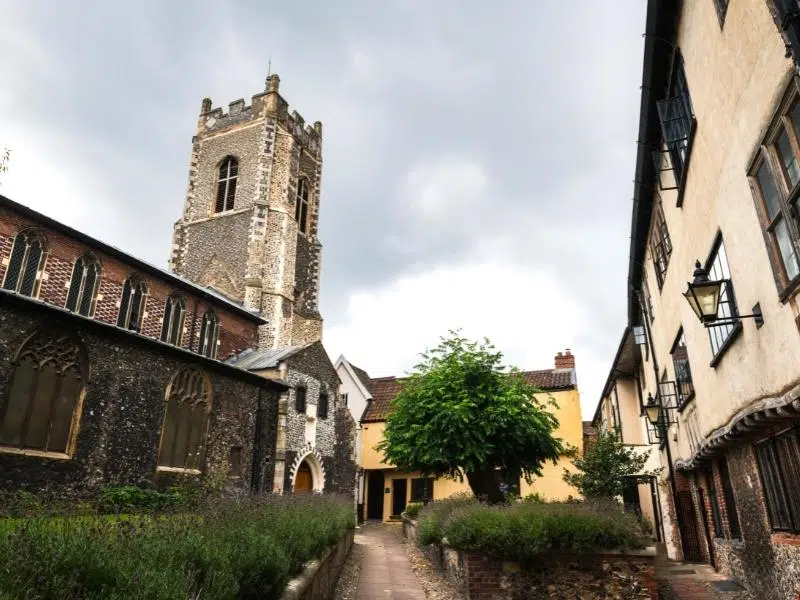
Mousehold Heath Earth Heritage Trail
Distance: 1.5 to 2 miles
Time: 30-40 minutes of walking, or longer for wildlife, picnic and running off into the woods to explore!
Suitability: Family and dog friendly, principle paths are pushchair and wheelchair accessible, but some points of interest off the paths may not be.
Mousehold Heath is a unique 88 hectares made up of heathland, woodland and recreational open space located in the north of Norwich, and a large local nature reserve valued for its wildlife and geological history. It’s a wonderful place to walk with kids and dogs, and enjoy city nature at its best.
The Earth Heritage Trail helps you discover the geological history of Mousehold Heath, and over two hundred years of quarrying for sand and gravel.
Thanks to its sandy soils, Mousehold Heath is a valuable example of heathland habitat, with a range of fascinating wildlife, including birds, lizards, frogs, butterflies, dragonflies and common woodland birds. Green and greater-spotted woodpeckers, sparrowhawks and kestrels are also sometimes seen.
There are eighteen waymarked points of interest along the trail and you can discover them in any order. Each point of interest links the landscape and wildlife of the Heath today with its deep geological history.
You can find a printable trail leaflet, with a map and lots of information about what you’ll see on the walk here.
RELATED POST: Norfolk Nature Reserves – Ultimate A-Z Guide
Norwich Nooks & Crannies Walk
Distance: 1.5 to 2.2 miles
Time: 30 minutes to a couple of hours of walking, more for stops, photographs and points of interest along the way.
Suitability: Family and dog friendly, pushchair and wheelchair accessible year round.
What in earth is a nook and cranny? Well, it means ‘everywhere’ as in “I’ve searched for it in every nook and cranny, and I still can’t find it“.
Nook, which has meant ‘an out-of-the-way corner’ since the mid-1300s is paired with cranny, which has meant ‘a crack or crevice’ since about 1440. So now you know!
The Norwich Nooks and Crannies Walk is actually composed of three short walks, the routes of which take you on a journey of discovery through many of the city’s historic cobblestone alleys, courts and lanes. Each route is walked to the stories or Norwich, some of which go back centuries.
All the walks start and finish in Norwich Market Place and take a fascinating journey around the city centre in a series of loops without ever crossing the same point twice, as you discover the city’s historic passageways on foot.
Split into three walks of 2.2 miles, 1.5 miles and 2 miles, the entire map details 50 passageways. You could do all three routes pn a large circular loop, which covers a total of 5.7 miles.
The furthest walking points will take you to a section of Magdalen Street to the north, Tombland to the east, King Street to the south and close to Grapes Hill in the west of the city.
Get your downloadable map, stories and walking routes here.
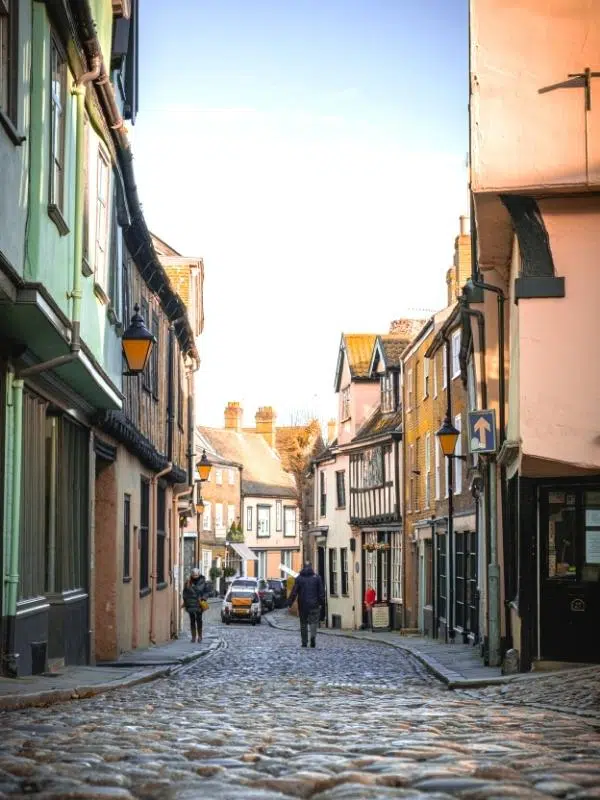
Norwich Ghost Walks
Distance: 1-2 miles
Time: 30-40 minutes of walking, but allow two hours for the tour, as you’ll be stopping to hear stories and maybe see ghosts!
Suitability: The walks are scary fun for everyone, except for young children or those who may be sensitive, so the recommended age is 10+. Dogs on a lead are welcome.
Ghost Hunters will love this evening adventure. Take a walk through the haunted medieval streets of Norwich and see the spooky side of Norwich Cathedral, Norwich Castle, Elm Hill, Tombland and the River Wensum
Your ghost-hunter guide will take you on a journey through the most haunted areas of the city, starting at the Adam and Eve pub, the oldest public house in Norwich, and share tales of the many lost spirits and poltergeists who are still seen, and heard, to this day.
Choose from the Elm Hill Walk along cobbled streets through the oldest part of Norwich, the River Walk where you’ll hear tales of its haunted past, or the Norwich Castle Walk, with its grisly history.
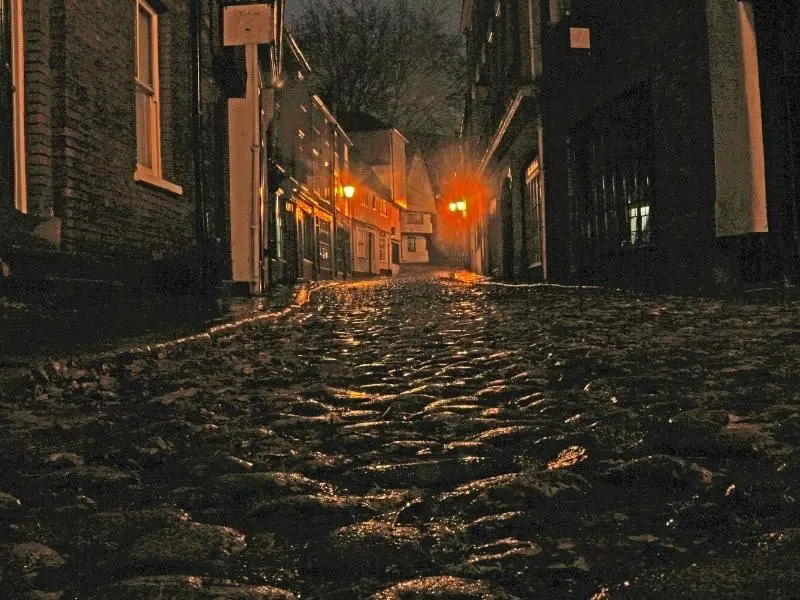
Have I missed your favourite Norwich city walk from my list? Let me know in the comments below and I’ll be sure to add it to my round-up of walks in Norwich!
Love it? Pin it!
